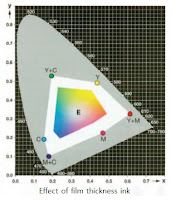Quality assurance in printing aims to
constant/fixed and correct/correct color reproduction/copying via
whole in the printing process. For printing ink and color
printing supplies, the most important parameter is film thickness
ink, halftone value, color balance, ink installation and
color series.
Ink film thickness
For technical reasons, the maximum ink film thickness is in
offset printing is about 3.5 m. For coated paper and
color process related to DIN 16 539 color location which
should be achieved/obtained with an ink film thickness between 0.7
and 1.1 m.
If lithography
it doesn't fit / doesn't
match, use
printing ink that is not
appropriate, however,
this could happen
that point of standardization
on the chromatic diagram
CIE not reached.
Color distance
reproduction also decreases
if the saturation is not
adequate.
In
white area picture
shows how narrow the color gap with the ink is
less in every three color processes.
In terms of physics, the effect of the thickness of the ink film on the
The view can be explained as follows.
Printing ink does not cover the paper; the ink is, somewhat, transparent.
Light enters/penetrates the ink.
In passing through ink, light
facing pigment that absorbs into wavelength
whichever is larger or smaller.
The higher the pigment concentration and the film thickness
The higher the ink/bigger, the more pigment is produced
incorporated by the incident light and, as a result, more is
absorbed.
In the end, the ray of light reaches the surface (white) on the
print and reflected supplies. On the way back to the light
has to go through the ink film again and only after that he can
captured/seen by the eye of the observer.
The thick printing ink film absorbs more light and
reflects less than the thin printing ink film; so that
observers see darker, more saturated colors, hues.
The part of the light that reaches the eye becomes suitable as
basis for estimating/grading each color.
















